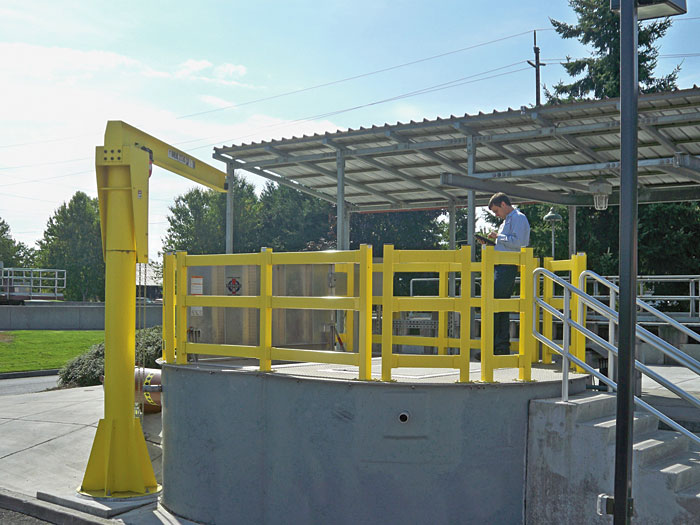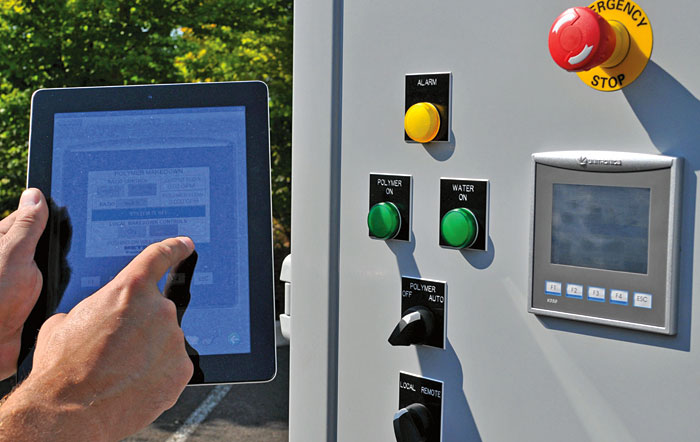Late in 2010, a packaged pumping system manufacturer provided a packaged pump station unlike anything it had built in the past. Scappoose, Ore., needed to upgrade its wastewater treatment plant. The consulting engineer required a pump station that would provide continuous, variable flow from its existing clarifiers while maintaining an operating range of 12 inches when pumping to a new filter station.
The Design Solution
Because of geological restraints, the only available site for the pump station was a narrow space between an existing road and previously installed process equipment. The packaged system provider proposed a version of its system used for submersible pumps, buried below grade. The wetwell with an integral valve vault was made from fiberglass and included an aluminum lid with access hatches. Because the station was only partially buried, the company was able to include safety handrails around the top perimeter for operator safety and a jib crane for equipment removal inside the station.
 |
Testing the Scappoose filter lift station with the mobile HMI. |
An Issue with the Sun
The package was completely assembled at the provider’s facility and delivered to the jobsite in one piece. The contractor provided installation, and the city was pleased with the quality of the station and the operation of the equipment.
However, one small problem existed that no one had considered—the sun. In Oregon, when the sun shines most people are happy. At the Scappoose WWTP, when the sun shone it meant that the operators had to wait for a dark cloud or dusk before they could work on the control system for the station.
The control panel provided was well optioned with a PLC and touch screen human machine interface (HMI) that was enclosed in a NEMA 4X stainless steel, dead front enclosure. However, once the dead front was opened to access the PLC’s HMI, it was difficult to read on a sunny day. Since this panel faced virtually due east, even on slightly overcast days, reading the display was difficult. Working with pumps or other equipment with a touch screen control system that is located outside can be problematic. Sun glare, driving rain, panels located remotely from the equipment are just a few extenuating circumstances that will make a nice installation difficult to operate.
A Solution for the Glare
For this reason, the packaged system provider decided to solve these control problems and unlocked a new way to establish onsite mobility and document management. This HMI fits right into the operator’s hands and can be taken anywhere and used at anytime. This was the beginning of a roving HMI and document management system designed to run on Apple’s iPad platform.
Thanks to the evolution of PLC technology for pumping control systems, control panel novices have a much easier time operating, maintaining, adjusting and understanding their control systems. This is in large part due to a general understanding of how to operate a personal computer. Computers make more sense to end users than ice cube relays, wire, switches and schematics. A PLC gives much the same feeling as a computer and many more options for controlling a system than a row of relays. However, all this technology is useless if the end user cannot see the screen to operate it.
Many PLC manufactures have a remote access program that can be used on a laptop computer to connect to the PLC. The problem is that most of these programs provide the data that the PLC has collected and some ability to change the operating parameters, but the end user experience is much different than standing in front of the control panel and operating the system. The screens look different—not to mention a laptop is not a touch screen. The biggest problem is that a laptop computer, while easier to carry than a desktop computer, is still not ideally mobile. Walking around with a laptop while typing is not easy.
The goal was to use a mobile device that more closely resembled the PLC’s touch screen HMI so that the operators felt as if they were holding the HMI in their hand. This would also give operators onsite mobility that effectively cut the umbilical cord between control panel and operator.
The Apple iPad was the best choice for making this happen since it is currently the most widely used tablet on the market. The packaged system provider’s team and an application programmer made the idea a reality. One year later, the application for the iPad was completed. During the year, several features were added and a second application was developed for managing and sharing the important documents pertaining to the pump system.
The HMI allows end users to use their iPads to connect to the PLC in their control systems. It works exclusively with certain color touch panel PLCs. It connects to the PLC via a local WiFi router that does not require an internet connection. The onsite mobility allows operators to move freely throughout their plant or station while monitoring or controlling the application. They can watch different parts of a process while maintaining full control of the PLC. Never again will they have to stand outside in the rain to access their system. Sunlight will not affect the visibility of their iPad as it does with outside, panel mounted screens. The best part of this system is that the iPad becomes the HMI and the graphics and controls rendering are the same as on the actual PLC. This allows the operator to switch from the mobile HMI to the PLC’s HMI and back seamlessly.
The document management application works directly with the mobile HMI to create a document management system unique for each piece of equipment to which the PLC is connected. It is a dynamic system because the operator and the pump station manufacturer share important documents regarding the pump station. The documents in the document management system are cached or stored on the iPad for offline use. This ensures that the operator will always have schematics, operation and maintenance checklists, photos, spread sheets, Microsoft Word documents and pdf files that are pertinent to each piece of equipment when and where they need it.
The HMI and document manager can be connected to as many PLCs as the owner has and can be expanded to control each future PLC. This allows for a cost-effective expansion when the operator decides to upgrade or add additional equipment. Additional options are also available that give end users offsite or remote access to each PLC.
 |
Testing the Mobile HMI in the sun |
The Freedom of Mobility
For Scappoose, the roving HMI for the iPad has solved a major problem that did not have many cost-effective solutions. By putting the PLC’s HMI on an iPad, the operators can now control and monitor their filter lift station and enjoy the freedoms of onsite mobility. They are able to check the system without opening the dead front panel, move directly over the wet well and watch the pumps operate while reviewing the trending chart rendering on the iPad. Also, they can sit at their desks and log in the pumps’ hours of operation.

